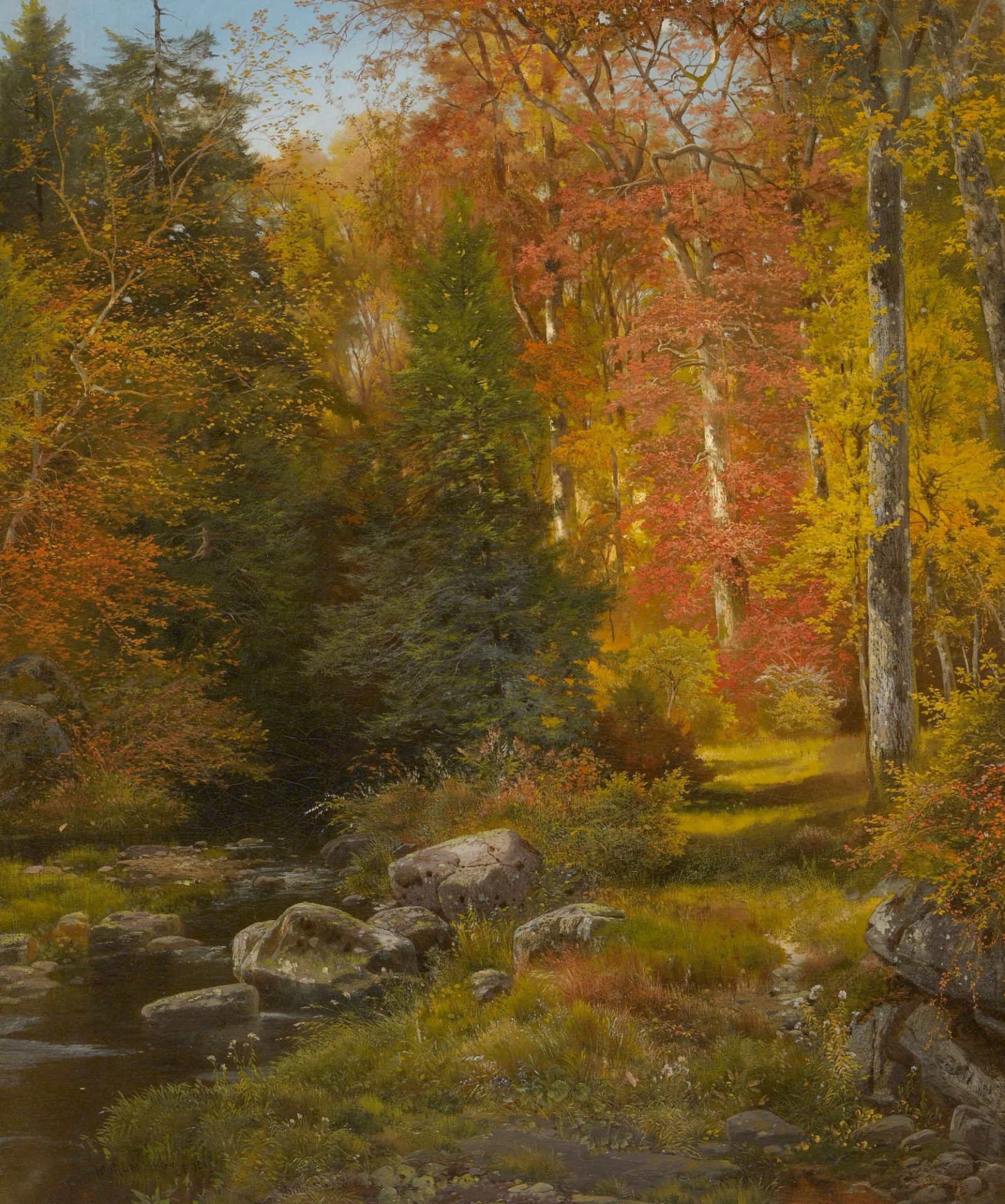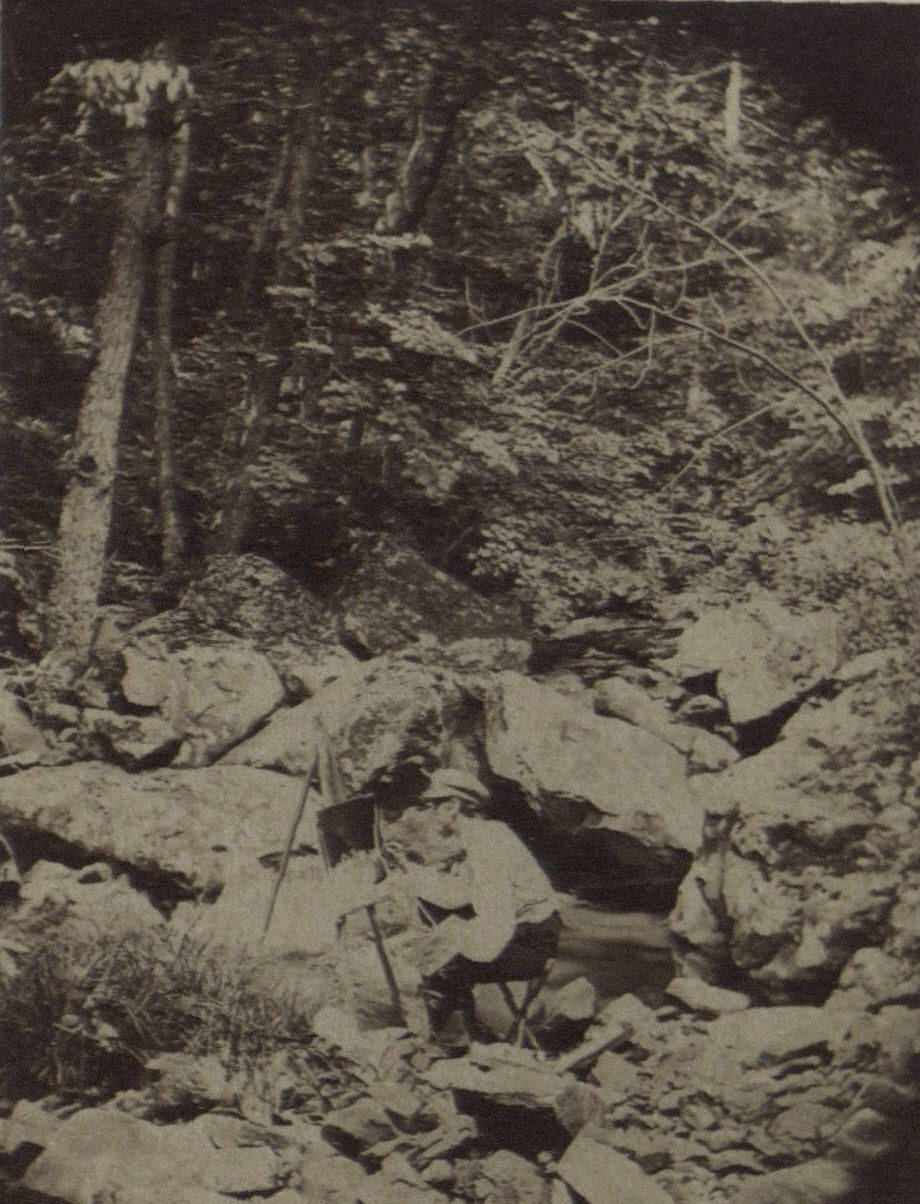 The Woods in Autumn (1864) by Thomas Moran (1837-1926) was an instant favorite of mine when I first arrived at the Museum in the Fall of 2010. Indeed, at first glance, I thought it was stunning; a very successful re-creation of autumnal splendor. Technically superb, the painting’s formal structure leads the eye into the landscape. Aided by the boulders at the lower left that point the way, Moran’s use of perspective creates a visual corridor that focuses your attention on the distant, sun-lit orange and crimson foliage seen just beyond a fall of darker evergreen trees. This pictorial arrangement creates a distant illuminated pocket of space that suggests the presence of an open meadow, just around the bend. Who knows what awaits there? Perhaps a parcel of deer with frolicking fawns, perhaps something more threatening like a mother black bear and cubs, which may require a tactful retreat? In any case, to me the painting creates a sense of exploration that frankly brought a smile to my face when I first saw it.
The Woods in Autumn (1864) by Thomas Moran (1837-1926) was an instant favorite of mine when I first arrived at the Museum in the Fall of 2010. Indeed, at first glance, I thought it was stunning; a very successful re-creation of autumnal splendor. Technically superb, the painting’s formal structure leads the eye into the landscape. Aided by the boulders at the lower left that point the way, Moran’s use of perspective creates a visual corridor that focuses your attention on the distant, sun-lit orange and crimson foliage seen just beyond a fall of darker evergreen trees. This pictorial arrangement creates a distant illuminated pocket of space that suggests the presence of an open meadow, just around the bend. Who knows what awaits there? Perhaps a parcel of deer with frolicking fawns, perhaps something more threatening like a mother black bear and cubs, which may require a tactful retreat? In any case, to me the painting creates a sense of exploration that frankly brought a smile to my face when I first saw it.
But now I find the painting even more poignant. As I write this, I am sequestered in my home on Long Island due to the 2020 COVID-19 pandemic, not far from one of the largest and most densely inhabited places in the country—New York City, the very epicenter of the coronavirus assault, with a lethality that is killing thousand of residents. This fact reminds me that the evolution of American landscape painting was very much a reaction to the not-so-civilized metropolis. In reality, the nineteenth-century American landscape tradition was an urban movement, having a lot to do with artists escaping cities and their unpleasantries and seeking refuge in nature. In this regard, I am reminded of a beautiful, prayer-like quote from Thomas Cole’s “Essay on American Scenery,” which alludes to the urban versus nature relationship:
 “He who looks on nature with a ‘loving eye’ cannot move from his dwelling without the salutation of beauty; even in the city the deep blue sky and the drifting clouds appeal to him. And if to escape its turmoil – if only to obtain a free horizon, land and water in the play of light and shadow yields delight – let him be transported to those favored regions, where the features of the earth are more varied, or yet add the sunset, that wreath of glory daily bound around the world, and he, indeed, drinks from pleasure’s purest cup.”
“He who looks on nature with a ‘loving eye’ cannot move from his dwelling without the salutation of beauty; even in the city the deep blue sky and the drifting clouds appeal to him. And if to escape its turmoil – if only to obtain a free horizon, land and water in the play of light and shadow yields delight – let him be transported to those favored regions, where the features of the earth are more varied, or yet add the sunset, that wreath of glory daily bound around the world, and he, indeed, drinks from pleasure’s purest cup.”
Ironically, the vibrant Fall colors rendered in Moran’s painting represent the final phase in the foliage’s annual life cycle. Giving way to Winter’s approach, the leaves soon provide a less than colorful carpet on the ground below. However, we know with confidence that the life cycle will begin again in the Spring. Let us hope that the virus’s life cycle will not.
Explore further:
View other works by Thomas Moran in our collection.
Search “Thomas Moran Photographs” in the collection of the East Hampton Library to see other images of the artist at work, on his travels, and at home on Long Island.


